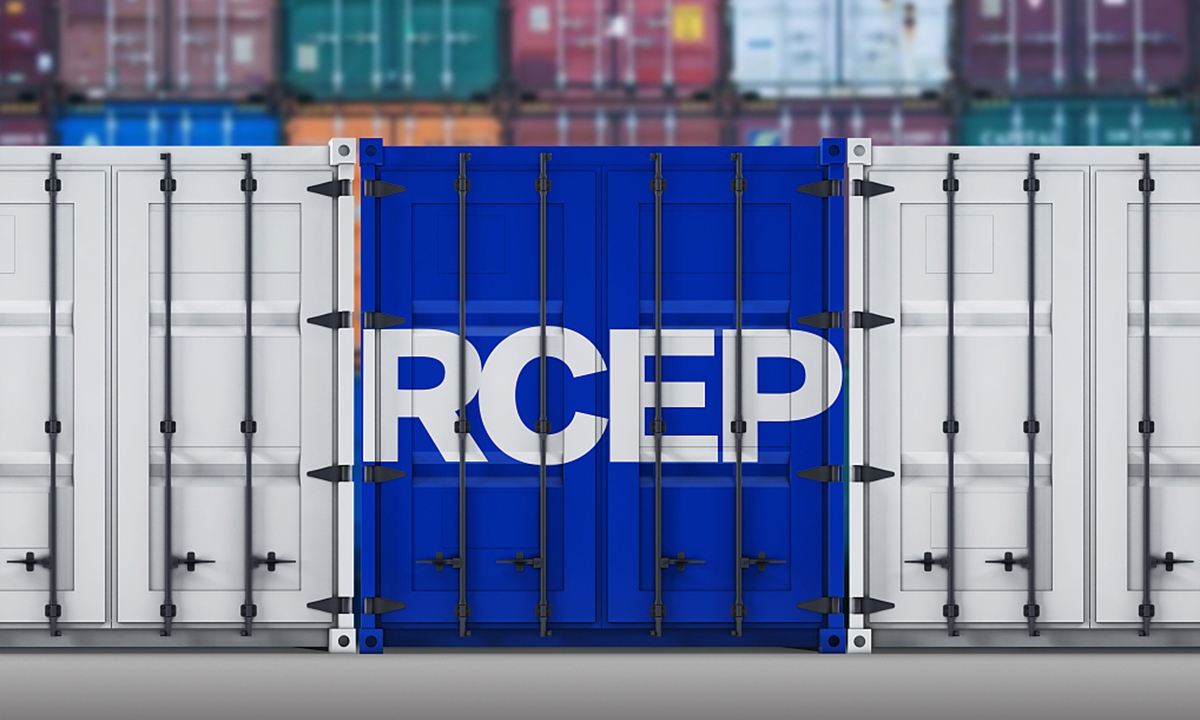
RCEP Photo:VCG
Chinese and Japanese manufacturers in South China's Guangdong Province, a global production hub, have gained from unprecedented tariffs reduction, with some set to save hundreds of thousands of yuan in 2022, after the Regional Comprehensive Economic Partnership (RCEP) took effect on January 1.
While auto manufacturing, the major industry involving regional cooperation, has made the earliest gains, industry analysts said that the RCEP will serve as a good start to put a regional free trade agreement among China, Japan and South Korea back on the table.
A business manager at a Guangdong-based car plant told the Global Times on Monday that it can see the direct benefits from the RCEP, since up to 60 percent of the company's spare parts including automatic transmissions are imported from Japan.
"After the implementation of the RCEP, our annual tariff reductions and exemptions are expected to reach 600,000 yuan ($94,440)," the manager said.
"We will consider increasing the import of components from countries that have signed the RCEP, such as Japan, to fully enjoy this policy dividend," he said.
There is huge connectivity between Japan and China in the vehicle industry. Within the RCEP agreement area, in terms of import value, Japan exported 79 percent of automatic transmissions for cars, 99 percent of vehicle engines, and 85 percent of car bodies to China in 2020, according to media reports.
"After the implementation of the RCEP, our company is expected to save about 900,000 yuan in 2022 in tariff cuts, accounting for 3.6 percent of our overall import tariffs.
"This figure is expected to account for 22 percent of overall import tariffs five years later," a general manager at a Guangzhou-based car spare parts company said after the RCEP took effect on Saturday.
Japan's Asahi Shimbun reported that after the RCEP took effect, the tariffs on Japanese export enterprises will eventually be reduced by 91.5 percent and the zero-tariff ratio for exports to China will increase from 8 percent to 86 percent, while the zero-tariff ratio for exports to South Korea will increase from 19 percent to 92 percent.
Moreover, Japan imported $3 billion in auto parts from China in 2019, about 10 times as much as in 2003, according to media reports.
Japan's medium- to high-end consumer products such as auto parts are expected to expand trade with China, which will give a strong boost to related industries in Japan.
While it is advantageous for Japanese parts to enter the Chinese market, China's new-energy vehicles can also get more access to the Japanese market after the RCEP came into force, Zhang Xiang, a research fellow at the Research Center of Automobile Industry Innovation under the North China University of Technology, told the Global Times on Monday.
He added domestic EV brands are taking the lead in increasing production capacity and ramping up technology innovation now.
For example, when Japan imports Tesla cars produced in Shanghai, the price will drop due to tariff cuts, and Japanese consumers will benefit, Zhang said.
What is seen in the car industry indicates a bigger potential for growth in East Asia and experts say that China, Japan and South Korea should build on the RCEP as a starting point for a future free trade deal between China, Japan and South Korea.
Shenzhen Huanggang Port ushered in the country's first imported goods after the RCEP took effect, with 5.6 tons of reflective film produced in Japan, which will be used to make backlight products such as mobile phones and digital cameras, according to media reports.
In the first year of the RCEP, the import tariff rate for reflective films produced in Japan has been reduced from 6.5 to 6.1 percent, and it is expected that annual tax savings of 500,000 yuan will be achieved.
"Since the RCEP is the first East Asian free trade framework, it can become a basis for bigger trade deals among China, Japan and South Korea," Xiang Haoyu, a research fellow at the China Institute of International Studies, told the Global Times on Monday.
In East Asia, where the world's most important industry chain base is located, there exists a larger room for further economic and trade integration, said Xiang.
China-Japan bilateral trade hit a record high in 2021, and it will get even bigger in 2022, experts said.




